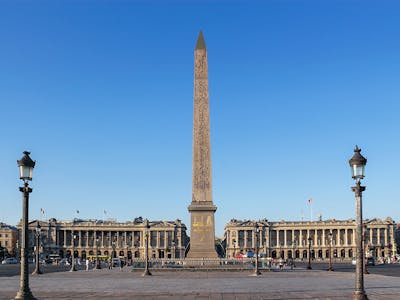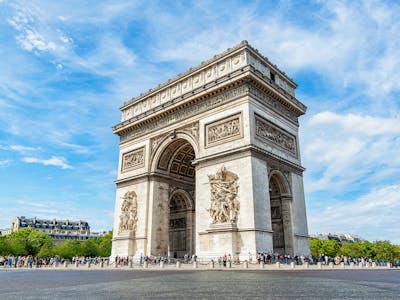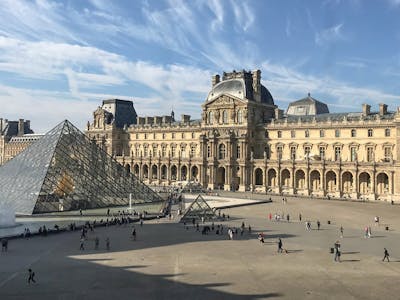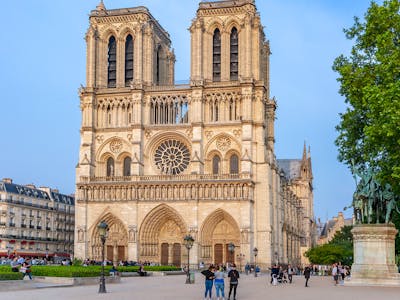Montmartre, nestled in the heart of Paris, is a vibrant and historic neighbourhood renowned for its artistic legacy. Home to the iconic Basilique du Sacré-Cœur, cobblestone streets, and a bohemian atmosphere, Montmartre captivates visitors with its charm, cafes, and panoramic views of the city.
Montmartre in a Nutshell
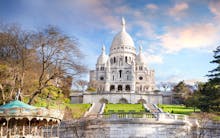


Handy information
| ⏰ Suggested Duration: | 1-2 hours |
| ☀️ Best Time to Visit: | Weekdays in the morning to avoid crowds |
| 🎟️ Entry Ticket: | €36.00 |
| 🚇 Closest Train: | Abbesses Station |
Must-see at Montmartre
- Sacré-Coeur Basilica
- Moulin Rouge
- Place du Tertre
- Café des 2 Moulins
Getting There
Address
Montmartre, 75018 Paris, France
Get Directions
Why is Montmartre worth visiting?
- Artistic Legacy: Montmartre has inspired countless artists, including Picasso and Van Gogh, with its bohemian spirit and vibrant creative energy.
- Breathtaking Views: Enjoy panoramic views of Paris from the steps of the Basilique du Sacré-Cœur, offering a stunning perspective of the city.
- Quaint Cobblestone Streets: Wander through charming streets filled with art studios, boutiques, and cafes, immersing yourself in the area's unique character.
- Cultural Landmarks: Explore cultural hotspots like the Moulin Rouge and the Place du Tertre, where street artists showcase their talent, adding to the neighbourhood's lively ambience.
- Historical Significance: Delve into Montmartre's rich history, from its role as an artistic hub in the 19th century to its resistance during World War II, adding depth to your visit.
- Bohemian Atmosphere: Experience the bohemian lifestyle, as Montmartre continues to be a haven for artistic expression, providing a distinct and authentic Parisian experience.
Recommended Montmartre Tickets
Depending on the kind of experience you seek and time in hand, you can choose from a variety of Montmartre tickets.
Montmartre History
Montmartre's history traces back to Gallo-Roman times, with archaeological evidence and early texts referring to Mount Mercury and Mount Mars. The hill gained religious significance after Saint Denis' martyrdom. King Louis VI built the church of Saint-Pierre and the Royal Abbey in 1134. In the 15th century, Montmartre became a village surrounded by vineyards.
During the 1590 Siege of Paris, it served as a strategic artillery position. The French Revolution led to the destruction of the abbey, making way for gypsum mines. In 1790, Montmartre became a commune, thriving in wine-making and gypsum mining. Annexed by Paris in 1860, it witnessed the revolutionary uprising of the Paris Commune in 1871.
The iconic Basilica of the Sacré-Cœur was constructed from 1876 to 1919, symbolising expiation for France's suffering in the Franco-Prussian War. By the 19th century, Montmartre was renowned for its cafés, cabarets, and artistic bohemia.

Montmartre Architecture
The architecture of Montmartre centres around the iconic Sacré-Cœur Basilica, a Romano-Byzantine masterpiece designed by Paul Abadie. Constructed with travertine stone, its exterior boasts a distinctive white façade. The interior, continuing the Romano-Byzantine style, exudes serenity, emphasizing the apse for liturgical reverence.
Initiated in 1875, completed in 1914, and consecrated in 1919, the basilica stands as a symbol of expiation. Montmartre's architectural uniqueness stems from its history as a village and later, a working-class enclave, drawing artists in the late 19th century. Lacking Haussmannian influence, Montmartre's charm lies in its picturesque streets, contributing to an unparalleled, bohemian atmosphere.
Highlights of Montmartre Paris
1Sacré-Coeur Basilica
The Sacré-Coeur Basilica, a masterpiece by architect Paul Abadie, stands atop Montmartre. Its dazzling white exterior, crafted from travertine stone, contrasts the cityscape. Inside, Romano-Byzantine architecture creates a serene atmosphere, emphasizing the apse for liturgical celebration. Completed in 1914, the basilica is a timeless symbol of Montmartre.
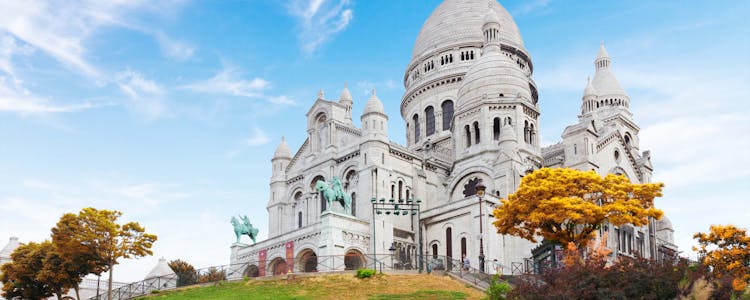
2Moulin Rouge
Since 1889, the Moulin Rouge has dazzled with can-can performances, defining Montmartre's nightlife. This iconic cabaret, featured in films, remains a cultural treasure. Guests experience a captivating blend of entertainment, fine dining, and Parisian glamour in the heart of Montmartre.
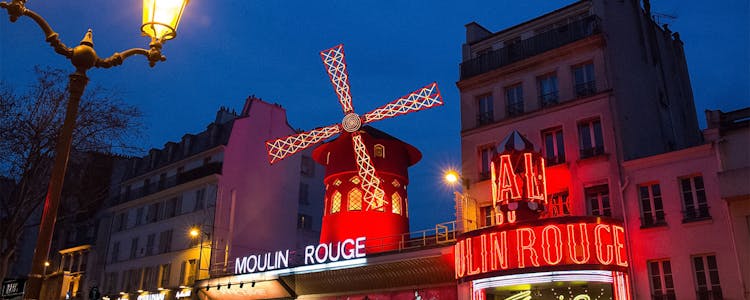
3 Rue des Abbesses
Discover the charm of Montmartre on Rue des Abbesses, a street lined with enchanting shops, cafes, and restaurants. Named after the Abbaye Royale de Montmartre, its medieval origins resonate. Locals and tourists alike are drawn to this picturesque street, capturing Montmartre's unique allure.
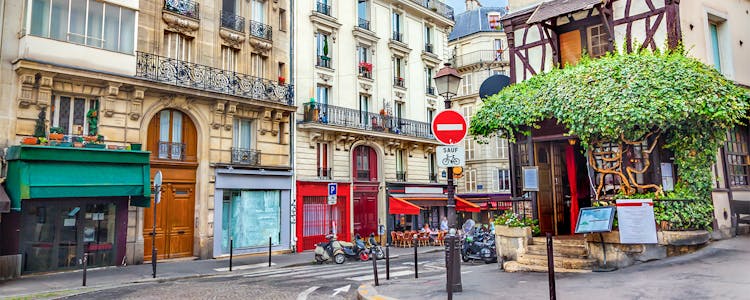
4La Maison Rose
On Rue de l'Abreuvoir, the pink-hued La Maison Rose beckons, once a gathering spot for artists like Picasso and Utrillo. Today, a restaurant, it radiates history, inviting visitors to savour its nostalgic charm and capturing the essence of Montmartre's bohemian past.
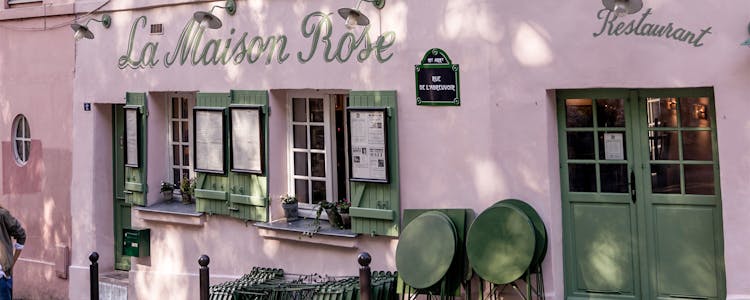
5Musée de Montmartre
Housed in a 17th-century building, the Musée de Montmartre, the former residence of Renoir, preserves the area's artistic legacy. A treasure trove of Renoir's works and exhibits celebrating Montmartre's vibrant history make this museum a must-visit, complemented by a delightful garden with panoramic city views.

6Tétre Funicular
Ascend Montmartre effortlessly via the Tétre Funicular, a cable railway inaugurated in 1900. Still operational, it offers panoramic city views, sparing visitors the ascent of steep stairs. A convenient and scenic journey, the funicular enhances the Montmartre experience, making its hilltop attractions easily accessible.

Best Time to Visit Montmartre
The best time to explore Montmartre is in the morning, preferably on a weekday, to relish the area's beauty without the bustling crowds. Early afternoons are also ideal, avoiding the evening rush. For a serene experience, opt for the shoulder seasons of spring and summer, with moderate weather and fewer tourists.
Summer highlights the district's vibrancy, showcasing the vineyard and wisteria. Fall offers charming autumn strolls, while winter, with a touch of snow, adds enchantment. Weekday visits in the morning or early afternoon ensure a more intimate encounter with Montmartre's allure.
Montmartre Tour Timings
- Montmartre Walking tour:
2 PM, daily - Montmartre Art tour:
10 AM, on Saturdays
Getting There
By Car
By Bus
By RER
By Metro
Insider Tips to Visit Montmartre
- The Sacré-Coeur and Place du Tertre, the main square, get very crowded later in the day. Arrive early to enjoy the sights without the throngs of tourists.
- Skip the tiring climb up the hill and take the funicular railway from Anvers station to Sacré-Coeur. The ride is quick and offers stunning views.
- Montmartre's magic lies in its hidden alleyways and squares. Wander around and discover charming cafes, independent shops, and secret gardens.
- Visit the Clos Montmartre, the last working vineyard in Paris, located on the hillside. You can learn about the winemaking process and even buy a bottle as a souvenir.
- Pick up some bread, cheese, and wine from a local market and enjoy a picnic in the Sacré-Coeur gardens or another scenic spot.
- Montmartre is a haven for artists and musicians. Watch a free concert in Place du Tertre or enjoy a mime show on the steps of Sacré-Coeur.
- The Marché aux Puces de Saint-Ouen is the largest flea market in Europe, perfect for finding unique souvenirs or vintage treasures.
- Montmartre was once a haunt for artists like Picasso and Van Gogh. Sit at a cafe like La Mère Catherine or Le Consulat and soak up the atmosphere.
- Learn how to make traditional French dishes like croissants or boeuf bourguignon at a local cooking school.
- Head to the Sacré-Coeur gardens or the terraces on Rue Lepic for breathtaking views of the city as the sun sets.
Montmartre Facts
- Montmartre only became part of Paris proper in 1860.
- Home to the last remaining vineyard within the city limits of Paris, Clos Montmartre is a 1.5-hectare plot that produces around 400 litres of wine each year.
- The Sacré-Cœur is built from limestone which bleaches itself. Perched atop the hill, it was built as a penance for the violence of the Commune in 1871.
- The name "Montmartre" comes from the "Mount of Martyrs" due to its history as a site of Christian martyrdom.
- Do you know what's the highest natural point in Paris? Hint: it's Montmartre!
- An artist’s haven, Montmartre has long been a magnet for geniuses like Van Gogh and Picasso in the late 19th century. The Place du Tertre, the main square, is still lined with easels where artists sell their work.
- Several iconic films have been set in Montmartre, including "Amelie," "Moulin Rouge!," and "Midnight in Paris." Retrace the steps of your favourite characters and see the real-life locations that inspired the silver screen.
- The iconic Moulin Rouge cabaret, immortalized in paintings and films, is located at the foot of Montmartre. It opened in 1889 and quickly became a symbol of Parisian nightlife and the can-can dance.
Restaurants Near Montmartre Paris

Step into Le Poulbot, a wallet-friendly eatery dishing out traditional French delights. Named after the famed artist Francisque Poulbot, celebrated for capturing Parisian street life, this spot brings you affordable French flavors with a touch of artistry.
Distance from Montmartre: 300 m
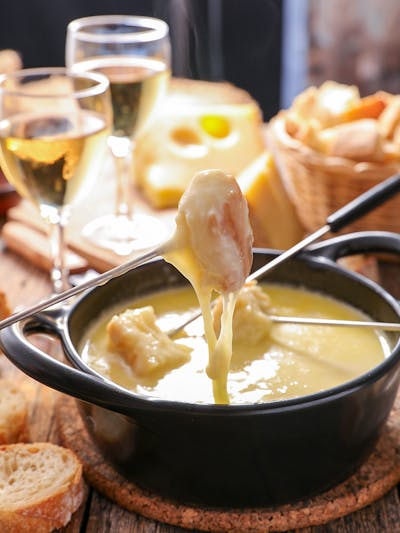
Cozy up at Le Refuge des Fondus, where indulgent fondues steal the show. This quaint spot is all about hearty cheeses and meats. Picture this: diners seated on benches, sipping wine from baby bottles—an experience as unique as the flavors.
Distance from Montmartre: 350 m

Join the legacy at Le Consulat, a historic café once favored by artistic greats like Picasso and Van Gogh. Today, it's a beloved hangout for locals and tourists alike, inviting you to savor a coffee or croissant amidst the enchanting Montmartre vibe.
Distance from Montmartre: 300 m
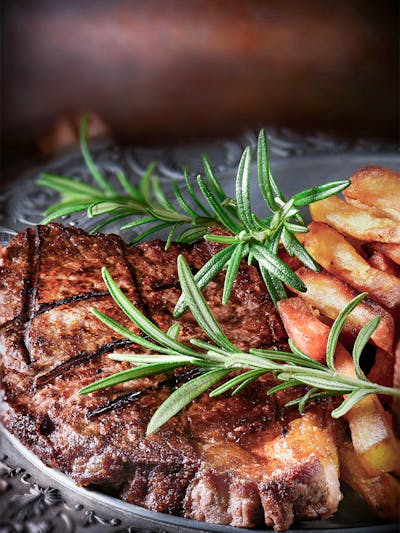
Time-travel to the 1800s at La Maison Rose, a pink marvel on Rue de l'Abreuvoir. From artists' canvases to your plate, this iconic house-turned-restaurant serves up classic French dishes, adding a touch of history to your dining experience.
Distance from Montmartre: 400 m

For a taste of classic French comfort, look no further than Chez Ma Cousine. This laid-back bistro offers familiar dishes at pocket-friendly prices. With warm service and a cozy atmosphere, it's a go-to spot loved by both locals and visitors.
Distance from Montmartre: 260 m
Places to Stay Near Montmartre Paris
Things to Do Near Montmartre Paris
FAQs
Yes, guided tour tickets for Montmartre are available, offering an enriching experience as you get insights into the area's history, art, and culture.
The best mode of transport to reach Montmartre is typically the Paris Metro, with stations conveniently located near the hill. Alternatively, buses and taxis offer accessibility.
A Montmartre tour often includes visits to iconic landmarks like the Sacré-Cœur Basilica, Place du Tertre, and artists' studios.
Taking a Montmartre tour in Paris offers a deep dive into the bohemian spirit, art history, and breathtaking views. It's a curated experience with insights that enhance appreciation for this unique district.
On a Montmartre tour, you'll see iconic landmarks such as Sacré-Cœur Basilica, Moulin Rouge, and Place du Tertre. The tour also explores the narrow cobblestone streets lined with artist studios and cafes.
A Montmartre tour can last from 45 minutes to 2 hours, depending on your choice of experience and tickets.
No, Montmartre tour tickets are generally pocket-friendly, with prices starting from €28.
No, Montmartre tour tickets do not include transportation.
Montmartre tours welcome individuals with visual impairments, permitting guide dogs to accompany them. However, it is advisable for those with reduced mobility to avoid walking tours for a more comfortable experience.



